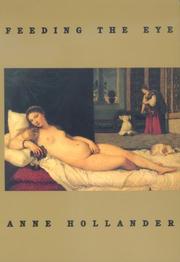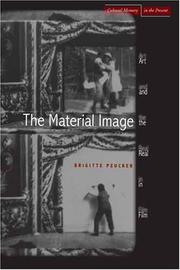| Listing 1 - 10 of 49 | << page >> |
Sort by
|
Year: 2020 Publisher: Amsterdam : Amsterdam University Press,
Abstract | Keywords | Export | Availability | Bookmark
 Loading...
Loading...Choose an application
- Reference Manager
- EndNote
- RefWorks (Direct export to RefWorks)
As the cinematic experience becomes subsumed into ubiquitous technologies of seeing, contemporary artworks lift the cinematic from the immateriality of the film screen, separating it into its physical components within the gallery space. How do film theorists read these reformulations of the cinematic medium and their critique of what it is and has been? Theorizing Cinema through Contemporary Art: Expanding Cinema considers artworks that incorporate, restage, and re-present cinema's configurations of space, experience, presence/absence, production and consumption, technology, myth, perception, event, and temporality, thereby addressing the creation, appraisal, and evolution of film theory as channeled through contemporary art. Taking film theory as a blueprint for the moving image, and juxtaposing it with artworks that render cinema as a material object, this book unfolds a complex relationship between a theory and a practice that have often been seen as virtually incompatible, heightening our understanding of each and, more pertinently, their interactions.
Art and motion pictures. --- Motion pictures --- Art and moving-pictures --- Motion pictures and art --- Motion pictures --- Philosophy.
Book
ISBN: 9781844576968 9781844576951 Year: 2014 Publisher: New York ; Basingstoke Palgrave Macmillan
Abstract | Keywords | Export | Availability | Bookmark
 Loading...
Loading...Choose an application
- Reference Manager
- EndNote
- RefWorks (Direct export to RefWorks)
Focusing on early cinema's relationship with the pictorial arts, this pioneering study explores how cinema's emergence was grounded in theories of picture composition, craft and arts education - from magic lantern experiments in 1890s New York through to early Hollywood feature films in the 1920s. Challenging received notions that the advent of cinema was a celebration of mechanisation and a radical rejection of nineteenth-century traditions of representation, Kaveh Askari instead emphasises the overlap between craft traditions and modernity in early film. Opening up valuable new perspectives on the history of film as art, Askari links American silent cinema with the practice of teaching the public how to appreciate fine art; charts its entrance into arts education via art schools and university film courses; shows how concepts of artistic production entered films through a material interest in the studio; and examines the way in which Maurice Tourneur and Rex Ingram made early art films by shaping an image of the film director around the idea of the fine artist
Cinéma --- Art et cinéma --- Motion pictures --- Art and motion pictures --- Histoire et critique --- History --- Art and moving-pictures --- Motion pictures and art --- Art et cinéma.
Book
ISBN: 9048542022 946298946X 9048561698 Year: 2020 Publisher: Amsterdam : Amsterdam University Press,
Abstract | Keywords | Export | Availability | Bookmark
 Loading...
Loading...Choose an application
- Reference Manager
- EndNote
- RefWorks (Direct export to RefWorks)
As the cinematic experience becomes subsumed into ubiquitous technologies of seeing, contemporary artworks lift the cinematic from the immateriality of the film screen, separating it into its physical components within the gallery space. How do film theorists read these reformulations of the cinematic medium and their critique of what it is and has been? Theorizing Cinema through Contemporary Art: Expanding Cinema considers artworks that incorporate, restage, and re-present cinema's configurations of space, experience, presence/absence, production and consumption, technology, myth, perception, event, and temporality, thereby addressing the creation, appraisal, and evolution of film theory as channeled through contemporary art. Taking film theory as a blueprint for the moving image, and juxtaposing it with artworks that render cinema as a material object, this book unfolds a complex relationship between a theory and a practice that have often been seen as virtually incompatible, heightening our understanding of each and, more pertinently, their interactions.
Art and motion pictures. --- Motion pictures --- Art and moving-pictures --- Motion pictures and art --- Philosophy. --- Art, Modern --- Contemporary art --- Modernism (Art) --- Film Theory, Installation Art, Objectness.

ISBN: 0520226593 9780520226593 Year: 2000
Abstract | Keywords | Export | Availability | Bookmark
 Loading...
Loading...Choose an application
- Reference Manager
- EndNote
- RefWorks (Direct export to RefWorks)
CDL --- 391 --- Art and motion pictures --- Art criticism --- Clothing and dress in art --- Clothing and dress --- Society and clothing --- Costume in art --- Art --- Arts --- Criticism --- Art and moving-pictures --- Motion pictures and art --- Motion pictures --- Social aspects --- Analysis, interpretation, appreciation

ISBN: 9780804754316 9780804754309 0804754314 Year: 2007 Volume: *11 Publisher: Stanford, CA Stanford University Press
Abstract | Keywords | Export | Availability | Bookmark
 Loading...
Loading...Choose an application
- Reference Manager
- EndNote
- RefWorks (Direct export to RefWorks)
Book
ISBN: 2850252131 9782850252136 Year: 1989 Publisher: Paris Hazan
Abstract | Keywords | Export | Availability | Bookmark
 Loading...
Loading...Choose an application
- Reference Manager
- EndNote
- RefWorks (Direct export to RefWorks)
Painting and motion pictures --- Peinture et cinéma --- Exhibitions --- Expositions --- schilderkunst --- film --- film en schilderkunst --- 75.036 --- 791.41 --- Peinture et cinéma --- Art and motion pictures --- Art and moving-pictures --- Motion pictures and art --- Motion pictures --- CDL
Book
ISBN: 1282750240 9786612750243 9882205283 9789882205284 9789622091764 9622091768 9789622091757 962209175X 9781282750241 Year: 2010 Publisher: Hong Kong : Hong Kong University Press,
Abstract | Keywords | Export | Availability | Bookmark
 Loading...
Loading...Choose an application
- Reference Manager
- EndNote
- RefWorks (Direct export to RefWorks)
Art, politics and commerce are intertwined everywhere, but in China the interplay is explicit, intimate and elemental, and nowhere more so than in the film industry. Understanding this interplay in the era of market reform and globalization is essential to understanding mainland Chinese cinema. This interdisciplinary book provides a comprehensive reappraisal of Chinese cinema, surveying the evolution of film production and consumption in mainland China as a product of shifting relations between art, politics, and commerce. Within these arenas, each of twelve chapters treats a particular histor
Motion pictures --- Motion picture industry --- Art and motion pictures --- Art and moving-pictures --- Motion pictures and art --- Film industry (Motion pictures) --- Moving-picture industry --- Cultural industries --- History. --- Political aspects --- Economic aspects --- Social aspects
Book
ISBN: 9048533996 9789048533992 9789462983649 946298364X 9048561442 Year: 2018 Publisher: Amsterdam : Amsterdam University Press,
Abstract | Keywords | Export | Availability | Bookmark
 Loading...
Loading...Choose an application
- Reference Manager
- EndNote
- RefWorks (Direct export to RefWorks)
The color films of French film director Robert Bresson (1901-99) have largely been neglected, despite the fact that Bresson himself considered them to be more fully realized reflections of his aspirations for the cinema. This study presents a revised and revitalized Bresson, comparing his late style to painterly innovations in color, light, and iconography from the Middle Ages to the present, to abstract painting in France after World War II, and to affinities with the avant-garde movements of Surrealism, Constructivism, and Minimalism. Drawing on media archeology, this study views Bresson's work through such allied visual arts practices as painting, photography, sculpture, theater, and dance.
Art and motion pictures. --- Art and moving-pictures --- Motion pictures and art --- Motion pictures --- Bresson, Robert --- Criticism and interpretation. --- Avant-garde (Aesthetics) --- Aesthetics --- Modernism (Art) --- Robert Bresson, intermediality, painting, the avant-garde, surrealism.
Book
ISBN: 9048551625 9463724036 9048561817 Year: 2021 Publisher: Amsterdam : Amsterdam University Press,
Abstract | Keywords | Export | Availability | Bookmark
 Loading...
Loading...Choose an application
- Reference Manager
- EndNote
- RefWorks (Direct export to RefWorks)
Film, like the printed imagery inaugurated during the Renaissance, spread ideas -- not least the idea of the power of visual art -- across not only geographical and political divides but also strata of class and gender. Moving Pictures and Renaissance Art History examines the early flourishing of film, from the 1920s to the mid-1960s, as partly reprising the introduction of mass media in the Renaissance, allowing for innovation that reflected an art free of the control of a patron though required to attract a broad public. Rivalry between word and image, between the demands of narrative and those of visual composition, spurred new ways of addressing the compelling nature of the visual. The twentieth century also saw the development of the discipline of art history; transfusions between cinematic practice and art historical postulates are part of the story told here.
Art and motion pictures. --- Motion pictures --- Art, Renaissance. --- History. --- Art, Renaissance --- Renaissance art --- Art and moving-pictures --- Motion pictures and art --- History and criticism --- gender, Hollywood, narrative, Renaissance. --- Art and motion pictures --- History
Book
ISBN: 1780934157 1474238459 147250352X 1472503538 1472544722 9781472544728 9781472503527 9781472503534 Year: 2013 Publisher: London : Bloomsbury Academic,
Abstract | Keywords | Export | Availability | Bookmark
 Loading...
Loading...Choose an application
- Reference Manager
- EndNote
- RefWorks (Direct export to RefWorks)
Joseph Cornell is one of the most significant American artists of the twentieth century. His work is highly visible in the the world's most prestigious galleries, including the Tate Modern and MOMA. His famous boxes and his collage work have been admired and widely studied.However, Cornell also produced an extraordinary body of film work, a serious contribution to 20th-century avant-garde cinema, and this has been much less examined.In this book, Michael Piggott makes the case for the significance of Joseph Cornell's films. This is an important contribution to our knowledge of twentieth century culture for scholars and students of film and art history and American studies and for all those interested in pop culture, celebrity and fandom.
Art and motion pictures. --- Cornell, Joseph --- Criticism and interpretation. --- Art and moving-pictures --- Motion pictures and art --- Motion pictures --- Kōneru, Jozefu, --- Kōneru, Jozefu --- History of art --- Film history, theory and criticism --- Popular culture
| Listing 1 - 10 of 49 | << page >> |
Sort by
|

 Search
Search Feedback
Feedback About UniCat
About UniCat  Help
Help News
News